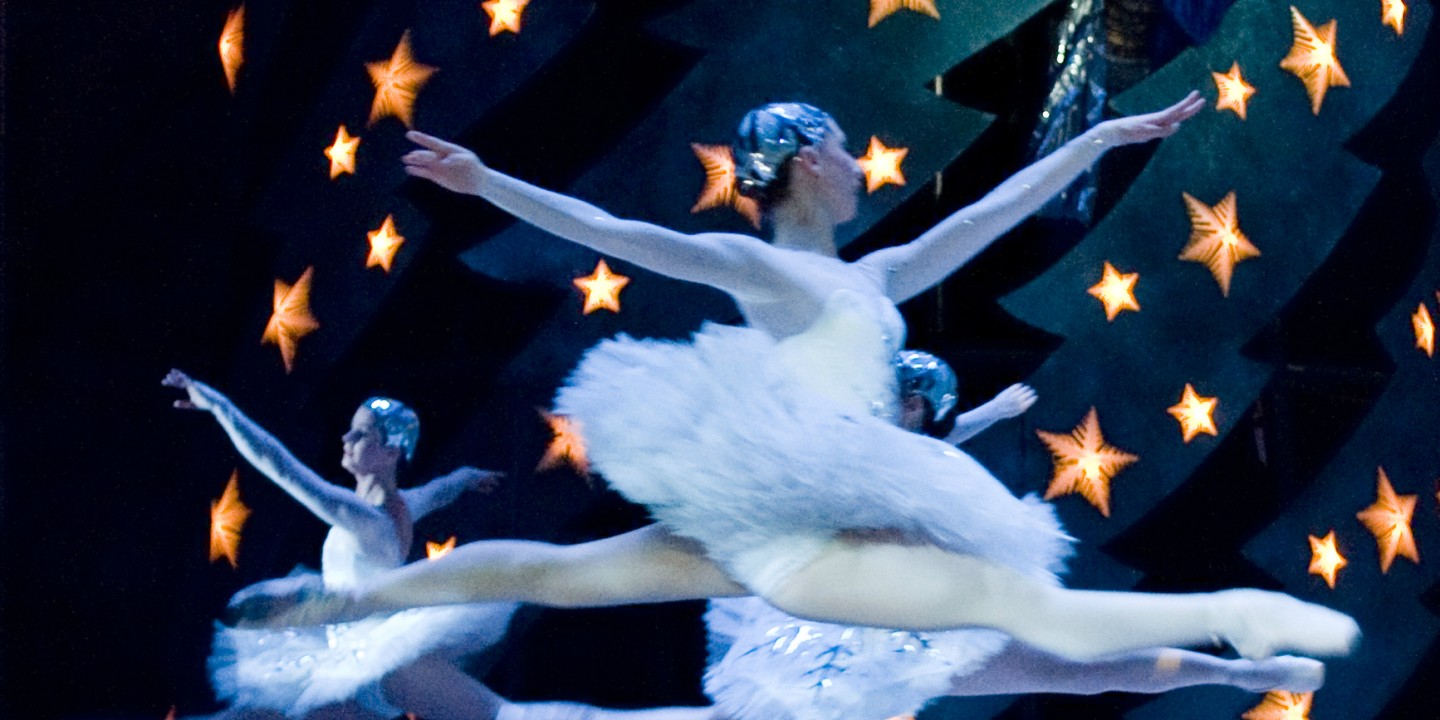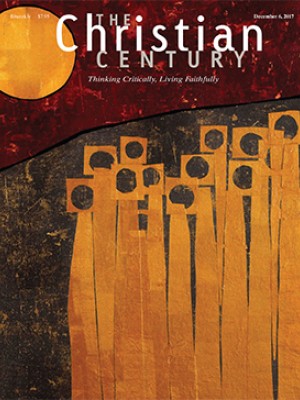How dancing in The Nutcracker has shaped my sense of Advent
When I read the annunciation story, I picture Mary as Clara.

Each Sunday in December, as our congregation lights the candles of the Advent wreath, I am reminded of a white taper candle I once held as a baby angel in my first performance of The Nutcracker. Since then I’ve played almost every part in the ballet, from baby angel to soldier to snowflake to Arabian dancer to the Dew Drop Fairy. For many people, The Nutcracker is a secular Christmas tradition. For me, it’s become part of preparing spiritually for Advent.
In 1979, the Tulsa Ballet’s production cast two baby angels, Kelsey and me. Although our choreography was quite simple—we were five years old—the baby angels were entrusted with the important task of carrying the light of hope and serving as divine companions to Clara, the ballet’s main character, through her coming-of-age journey. We were costumed entirely in white—and wire. Wire suspended a delicate halo above my head; more wire lined the tulle of my unwieldy hoop skirt which kept me from sitting down or maneuvering easily around the set.
Read our latest issue or browse back issues.
Our guide was Ms. Larkin, our everyday ballet teacher. To the world, she was known as Moscelyne Larkin, one of the five Native American ballerinas who toured with the Original Ballet Russe and Ballet Russe de Monte Carlo in the 1940s. While on tour she met her husband, Roman Jasinski, with whom she founded the Tulsa Ballet.
Ms. Larkin explained to us during rehearsal that Clara must go through an arduous journey into battle against the Mouse King and his minions. Our role as baby angels was to protect Clara and provide her with divine encouragement. We accepted our choreographic mission with wide eyes and earnest hearts. Here we are; let it be with us according to your word.
In act 1, the baby angels enter after the festive party is over but before the battle between mice and soldiers begins. In Clara’s dreams, the familiar surroundings of her home disappear. While the transformation onstage was magical—walls flew away and furniture danced offstage—backstage it was a nightmare. Grips raised and lowered scrims and backdrops, while furniture and step units from the party scene spun awkwardly around as stagehands pushed and pulled them away.
Kelsey and I hopped and shuffled and ducked in a dark, backstage version of Frogger. We prayed that we wouldn’t get crushed or, worse, yelled at for being in the way. All the while, we listened to the music, trying to keep track of the musical counts that dictated our entrance.
We knew the time for our entrance was near when we saw the baby mice enter the stage to bully Clara. In fear, she collapsed center stage. Was all lost before the battle had even begun? We smiled in the wings, because this was our moment. Our dance would tell Clara and the audience, We got this. Light and life will prevail.
We shuffled across the dark stage, the only light emanating from the battery-powered candle we each clasped in both hands. We entwined our fingers around the tapers as if in prayer. As we bent our knees in a slight plié, our hoop skirts skimmed over the floor to give the illusion of us flying to assist Clara, still collapsed in fear on the floor. Kneeling on each side of her, we lifted the candles high over our heads and then opened our arms in a praise-filled port de bras. Though tiny, we filled the dark, empty stage with a small, persistent light—and Clara stirred.
She sat up, looked to each of us, and then steeled herself for the battle to come. We shuffled off stage, ready for our next entrance.
Reading Luke’s account of Gabriel’s visitation to Mary, I often pictured Mary as Clara. In a dream, the familiar surroundings of Mary’s Galilee home melt away as if pulled by divine stagehands. The powers of evil and darkness are all around. King Herod and his minions scurry and create enough havoc to make any Mouse King proud, but the angel Gabriel helps her steel herself to give bodily witness to the light of the world.
Joseph, like a valiant Nutcracker Prince, acts as a companion. But Mary must believe, choose, and act on her own. In faith, what she has and who she is will be enough to make the impossible a reality. Like Clara, Mary will come of age quickly. She will learn to focus on the salvation in her midst.
The baby angels’ final entrance comes after Clara throws her shoe at the Mouse King, effectively disarming him and winning the battle for good. As the mice pull their king into the wings, Clara dances an ecstatic round of tour jetés across the stage. I imagined her joyous dance as a choreographic version of the Magnificat, in which Mary sings to Elizabeth of justice, hope, and divine election.
After Clara’s dance, the other baby angel and I led her to the Land of Sweets through a gentle snowfall to the warm welcome of the Sugar Plum Fairy. The Sugar Plum Fairy was our favorite. We quickly changed out of our angel costumes and snuck backstage to study her every move. We spoke of her in hushed tones. “She’s warming up her feet now . . . I want orange leg warmers like hers.” Each evening, we counted the moments until she began her iconic solo variation.
We could not ignore the pathos of the adagio that the Sugar Plum Fairy and her cavalier first dance together. This mournful pas de deux always felt at odds with the levity of the act 2 variations—at least until I learned that Tchaikovsky’s sister died while he was composing the score. Musicologist Roland John Wiley has noted the “prayer-like insistence” with which the adagio’s main theme is repeated. In Nutcracker Nation, dance critic and historian Jennifer Fisher recounts Wiley’s theory that this melodic phrase, a descending major scale, “might have been Tchaikovsky’s hidden homage to his sister”—it recalls the setting of the words “as with the saints give rest” in the Russian Orthodox funeral service. The adagio embodies Tchaikovsky’s grief.
The sad swells of those scales now remind me that even the ruler of the Land of Sweets knows darkness and despair. Like Mary, whose grief will pierce her soul, the Sugar Plum Fairy knows loss.
But I think she also knows that death does not have the final word. This moving dance is immediately followed by her solo, which is marked by the otherworldly, resonant chimes of the celesta. Tchaikovsky had just discovered the instrument, and he purposefully paired it with the ballerina’s dance. As the music begins, she flicks her hands to every corner of the stage, as if throwing off the darkness and claiming that the light of hope is with her and is her gift to share with the world. Her triumphant solo suggests that, though weeping lingers for the night, joy comes in the morning. After the Sugar Plum Fairy’s dance ends, morning dawns for Clara. Her dream ends. She awakens at home with a maturing sense of self, fueled by wide-eyed wonder and joy.
Each week of Advent, the light grows stronger as more candles are lit, culminating on Christmas Eve in a sanctuary filled with light. As I grasp my lit candle and sing “Silent Night,” I am transported back to my days as a baby angel, when I first learned that women like Mary, Elizabeth, Clara, and the Sugar Plum Fairy can be messengers of the divine. I dance alongside a diverse communion of saints who give witness to the light that shines in the darkness and cannot be overcome.
A version of this article appears in the December 6 print edition under the title “I was a baby angel.”






